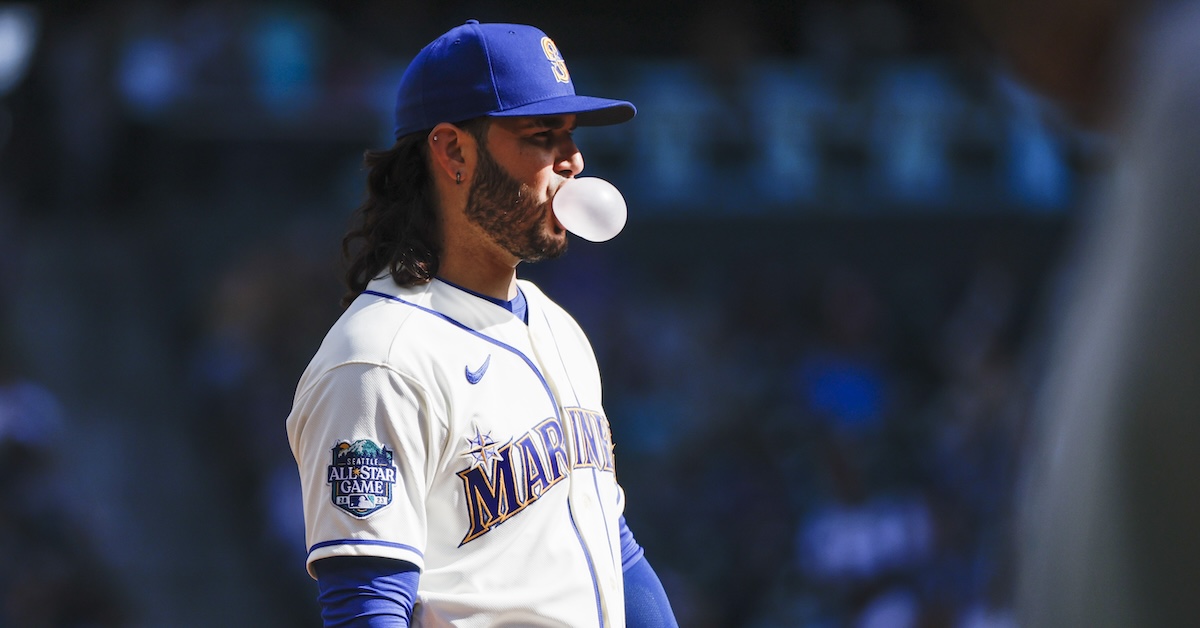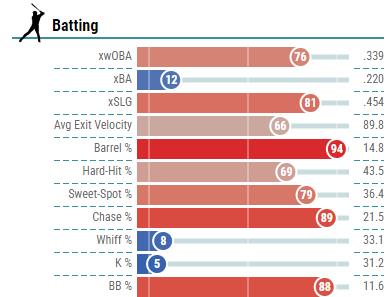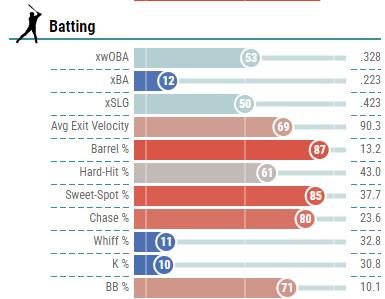
Joe Nicholson-USA TODAY Sports
Up in Seattle, the Mariners had a problem. Eugenio Suárez, who the team initially acquired as salary ballast in the trade that brought them Jesse Winker, was due to make $11 million next year – $13 million if you count a buyout on a team option for 2025. This wasn’t a huge problem – Suárez had been solid since joining the team, racking up 7.3 WAR in two seasons – but for a club whose payroll has bounced around between $110 million and $140 million in recent years, it’s a sizable chunk of the puzzle.
What’s more, Jerry Dipoto telegraphed the team’s intention to favor long-term budget sustainability over short-term upgrades in his now-infamous 54% remark. Dipoto apologized for the tone of those comments – “doing the fans a favor” is just not a good way to phrase things – but the broad point was hard to miss. The Mariners are committed to building their team for the long run on their own terms, which seems to mean prioritizing payroll savings and cost-controlled players wherever possible.
When the team traded for Luis Urías, the writing was on the wall: Suárez was going to get traded. A franchise that thinks long and hard about every dollar it spends probably wouldn’t pick up a platoon/backup infielder making roughly $5 million in arbitration; he was the eighth-highest-paid player on the team, a baffling use of resources given the constraints. So someone had to go, and the obvious bet was Suárez. Now the Mariners just needed a trade partner.
Luckily, the answer was only a time zone away. Nobody wanted to admit it during the Diamondbacks’ playoff run, but third base was a problem for them. Evan Longoria was a fun story, a veteran presence on a team of brash youngsters, but he struck out 30% of the time, a career high, and posted an overall line only a tenth of a win above replacement level. He’s also a free agent, but even if the Diamondbacks were to bring him back, he’s probably not a key contributor at this stage of his career. Emmanuel Rivera, who played 65 games at third, is a better fielder but a worse hitter. That’s an extremely weak position for a playoff contender, let alone one that just appeared in the World Series.
We’re somewhat far into this article, but here’s the trade: Suárez goes to the Diamondbacks in exchange for catcher Seby Zavala and reliever Carlos Vargas. If you got a lot of your knowledge about the Diamondbacks from their playoff run this fall, you might say “who?” That’s because neither Zavala or Vargas appeared in the postseason. That’s a fair criticism of the trade – the return is definitely on the light side – but they’re at least somewhat interesting in their own right.
Zavala is an archetypical backup catcher. He popped a 110 wRC+ in limited action in 2022, leading to a career year, but that’s not his skill set. He’s a great blocker and receiver, finishing in the top 10 for blocking runs and top 15 for framing runs despite barely catching 500 innings in 2023. He struggled to control the running game, but made up for it with the rest of his defensive excellence. He also can’t hit, but that’s par for the course with backup catchers. He’ll start the season as Cal Raleigh’s understudy, a role the Mariners really needed to fill; otherwise, they’d be dipping into free agency for a part-time player.
Vargas unquestionably has more upside than Zavala. He’s a two-pitch reliever, but those two pitches are both huge. He touches 100 with a four-seamer and has a transcendent lower-90s cutter/slider hybrid. It’s a unicorn of a pitch; across all big leaguers, only Joe Kelly threw a slider or cutter with his combination of downward movement and velocity. When batters gear up for 100 and get a pitch that is still fast enough to make you miss, but also drops 20 inches more than his fastball, they’re prone to looking silly. Vargas also mixes in a sinker, and even the occasional changeup, but his four-seamer and breaking ball are his main assets.
There’s obviously going to be a “but” here; after all, the Diamondbacks could have used another impact reliever this October. Vargas struggles exactly where you’d guess – with his command. He walked 15% of the batters he faced in Triple-A this year, then walked 18% of opponents in a brief major league cameo. He also shockingly struggled to miss bats, posting a career-low 9.5% swinging strike rate in the minors. My guess is that a lot of that is command – you get fewer bad swings when you’re behind in the count – and some is a flatter fastball than in previous years.
Either way, Vargas is a high-risk/high-reward option for the Mariners, who have done a great job unlocking a new level in their relievers in recent years. Heck, they just traded Paul Sewald to the Diamondbacks to fill in some major league roster holes. Dominic Canzone and Josh Rojas, both acquired for Sewald, are part of the reason the team decided to trade Suárez at all. If they can work with Vargas to get the most out of that hellacious cutter, they might have another fine addition to their bullpen collection.
Those are the bit parts; Suárez is obviously the main attraction in this trade. He slots in towards the top of Arizona’s lineup right away, a righty home run threat to complement the speed and on-base percentage at the top of the lineup. The Diamondbacks were light on firepower in 2023 and succeeded in spite of it; in an ideal world, Suárez transmutes a roster spot that used to be a weakness into a strength.
Working against that interpretation of things: Suárez wasn’t a particularly great hitter in 2023. He was still quite valuable, but a huge chunk of that value came from his defense at third base. He posted a 102 wRC+ thanks to a 30.8% strikeout rate. That makes three out of the last four years where his wRC+ has been no better than 102, an arbitrary cutoff, to be sure, but a worrisome sign nonetheless.
Suárez’s game has always involved plenty of strikeouts; in 2022, for example, he struck out 31.2% of the time but was still 30% above average offensively. He makes the whole package work by putting the ball in the air and, frequently, out of the park. From 2016 through 2022, he posted a .229 ISO and hit 207 homers, sixth-most in baseball. Some of that can be attributed to the hitter’s park in Cincinnati where he spent most of those years, but he launched 31 homers in Seattle in 2022. He has a gift for getting his barrel on the ball and putting it in the air.
He didn’t do anything obviously different in 2023 that led to a worse offensive performance. Here’s a fun way of looking at it; take a look at his Statcast bar graphs for 2022:

And 2023:

As you can see, he repeated the same skills in both years. He doesn’t chase very often, though when he does, he swings and misses frequently. He hits the ball at homer-friendly angles quite often – that’s sweet spot rate, more or less. He hits the ball hard at those angles a lot – barrel rate. And that power, combined with his batting eye, leads to plenty of walks. The problem is that all those skills eroded just a little bit in 2023, and to be fair he got a bit unlucky on batted balls to boot.
His all-or-nothing style has produced seasons like this before, and it will do it again. It also puts a lot of pressure on his power; he’s a lock to strike out a ton, so he needs a pile of homers to make up for that. If the ball is flying next year, he’ll be a big beneficiary. A word of warning for Arizona, though: Chase Field is a lousy park for home run hitters these days. The new environment and a natural aging curve lead me to think Suárez will end up right around average offensively.
That will likely be fine with the Diamondbacks, particularly if he plays good defense at third. He’s historically been an asset defensively, with enough range that the Reds once tried to move him to shortstop, with disastrous results to be fair. I see no reason to think he’ll fall off a cliff defensively, but I also don’t think he’s as good as OAA made him out to be in 2023. Defensive metrics are notoriously variable from one year to the next, and DRS thought he was below average, a far cry from the Statcast-enabled metric that loves him.
Put this all together, and Suárez looks like an average contributor in 2024. Expecting him to reprise his excellent 2022 seems unlikely. He’s getting older. He’s probably not one of the best defensive third basemen in the game. But he’s a competent hitter who can play a position where Arizona didn’t have much going on. Over the long grind of a baseball season, avoiding gaping holes in your lineup pays huge dividends. This trade does just that for the Diamondbacks as they attempt to defend their National League crown.
As much as I’m praising Arizona’s side of the deal, I’m not too keen on Seattle’s end, though I understand how it’s logically consistent with the approach to roster building and payroll they’ve settled on. I find their overly miserly spending strategy extremely frustrating; I’m not advocating for a perennial $250 million payroll or anything, but pinching relative pennies when you have Julio Rodríguez and several prime-age pitchers under team control feels like a bad understanding of what’s important. Teams don’t hit Dipoto’s mythical .540 winning percentage by always trying to have one foot in and one foot out; they do it by trying hard to compete when the major league roster is set up for success.
Now that I’ve lodged my complaints about the Mariners’ overarching strategy, though, let’s set that aside for a moment. If they’re going to operate in this strange space where they always try to spend a little to succeed a lot, replacing Suárez with Urías probably moves the needle in the right direction. I think it’s likely that Urías will outproduce Suárez in 2024, and he’s more likely to stay healthy too. If you’re truly dead set on minimizing salary outlay, this switch makes good sense. Vargas might be a plus bullpen arm fairly soon, Zavala provides competent backup catching at a good rate, and it’s not clear that the Mariners’ starting nine is any worse now than it was three weeks ago. Since the Mariners sent a reliever in exchange for Urías, you could pitch this as them coming out net even on the reliever front, even on the third baseman front, and scooping up a backup catcher while saving more than $5 million.
Again, I wouldn’t do that! They haven’t improved their depth at all, and Vargas isn’t as good as Isaiah Campbell, the departed reliever in question. It’s a lot of shuffling without much gain, and the bottom of the Seattle lineup is still dicey. Honestly, dicey might even be giving them too much credit; it’s a pile of platoons with limited major league success. They could just have Urías and Suárez and raise the floor of the team meaningfully. Making salary-saving trades that clearly make the team worse in 2024 is weird when they have a superstar and some complementary pieces.
To recap, the Diamondbacks are getting an upgrade at the cost of two players they didn’t plan on using very much. The Mariners are getting the salary relief they so desperately crave. Both teams can win in this deal, at least in their own accounting, because they have different goals. I think Seattle’s goals are wrong – but if you separate that out, I think they’re at least going about their goals logically. Damning with faint praise? Perhaps, but it’s better than the alternative, and there’s no better way to spin trading one of your team’s four best hitters in the past two years for spare parts.
Source
https://blogs.fangraphs.com/eugenio-suarez-available-for-cheap-to-a-good-home/
 Backyard GrillingWeekend WarriorsAdvice from DadBeard GroomingTV Shows for Guys4x4 Off-Road CarsMens FashionSports NewsAncient Archeology World NewsPrivacy PolicyTerms And Conditions
Backyard GrillingWeekend WarriorsAdvice from DadBeard GroomingTV Shows for Guys4x4 Off-Road CarsMens FashionSports NewsAncient Archeology World NewsPrivacy PolicyTerms And Conditions
